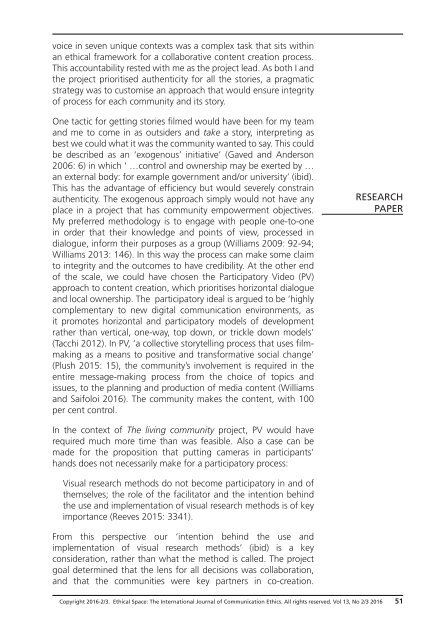Beyond clickbait and commerce
v13n2-3
v13n2-3
Create successful ePaper yourself
Turn your PDF publications into a flip-book with our unique Google optimized e-Paper software.
voice in seven unique contexts was a complex task that sits within<br />
an ethical framework for a collaborative content creation process.<br />
This accountability rested with me as the project lead. As both I <strong>and</strong><br />
the project prioritised authenticity for all the stories, a pragmatic<br />
strategy was to customise an approach that would ensure integrity<br />
of process for each community <strong>and</strong> its story.<br />
One tactic for getting stories filmed would have been for my team<br />
<strong>and</strong> me to come in as outsiders <strong>and</strong> take a story, interpreting as<br />
best we could what it was the community wanted to say. This could<br />
be described as an ‘exogenous’ initiative’ (Gaved <strong>and</strong> Anderson<br />
2006: 6) in which ‘ …control <strong>and</strong> ownership may be exerted by …<br />
an external body: for example government <strong>and</strong>/or university’ (ibid).<br />
This has the advantage of efficiency but would severely constrain<br />
authenticity. The exogenous approach simply would not have any<br />
place in a project that has community empowerment objectives.<br />
My preferred methodology is to engage with people one-to-one<br />
in order that their knowledge <strong>and</strong> points of view, processed in<br />
dialogue, inform their purposes as a group (Williams 2009: 92-94;<br />
Williams 2013: 146). In this way the process can make some claim<br />
to integrity <strong>and</strong> the outcomes to have credibility. At the other end<br />
of the scale, we could have chosen the Participatory Video (PV)<br />
approach to content creation, which prioritises horizontal dialogue<br />
<strong>and</strong> local ownership. The participatory ideal is argued to be ‘highly<br />
complementary to new digital communication environments, as<br />
it promotes horizontal <strong>and</strong> participatory models of development<br />
rather than vertical, one-way, top down, or trickle down models’<br />
(Tacchi 2012). In PV, ‘a collective storytelling process that uses filmmaking<br />
as a means to positive <strong>and</strong> transformative social change’<br />
(Plush 2015: 15), the community’s involvement is required in the<br />
entire message-making process from the choice of topics <strong>and</strong><br />
issues, to the planning <strong>and</strong> production of media content (Williams<br />
<strong>and</strong> Saifoloi 2016). The community makes the content, with 100<br />
per cent control.<br />
RESEARCH<br />
PAPER<br />
In the context of The living community project, PV would have<br />
required much more time than was feasible. Also a case can be<br />
made for the proposition that putting cameras in participants’<br />
h<strong>and</strong>s does not necessarily make for a participatory process:<br />
Visual research methods do not become participatory in <strong>and</strong> of<br />
themselves; the role of the facilitator <strong>and</strong> the intention behind<br />
the use <strong>and</strong> implementation of visual research methods is of key<br />
importance (Reeves 2015: 3341).<br />
From this perspective our ‘intention behind the use <strong>and</strong><br />
implementation of visual research methods’ (ibid) is a key<br />
consideration, rather than what the method is called. The project<br />
goal determined that the lens for all decisions was collaboration,<br />
<strong>and</strong> that the communities were key partners in co-creation.<br />
Copyright 2016-2/3. Ethical Space: The International Journal of Communication Ethics. All rights reserved. Vol 13, No 2/3 2016 51


